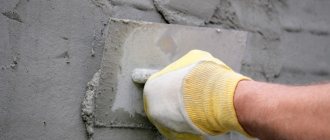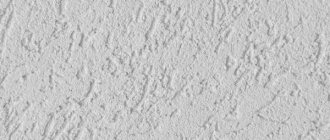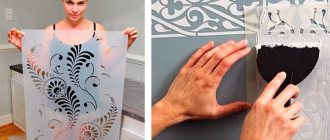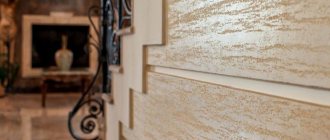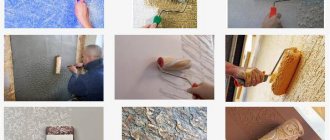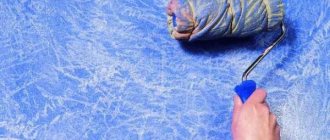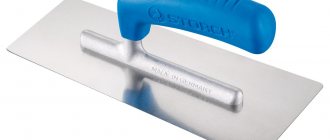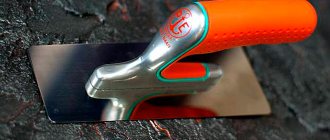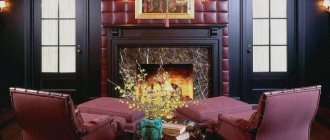Dimensions
By width, ordinary metal spatulas are divided into narrow, medium, wide:
- A narrow tool is considered to be a tool with a working plate 5 to 10 cm wide. With its help, it is convenient to scoop up plaster or putty mixture from a bucket and throw it on the wall. The small width also makes it possible to plaster in hard-to-reach places. It is difficult to level the solution over the surface being treated with such a tool.
- Medium products include products with a blade 15-25 cm wide. Individual large dents are puttied with this spatula. The tool is well suited for leveling small areas and grouting gypsum board joints.
- Wide (facade) spatulas are equipped with a plate larger than 25 cm. Available sizes: 30, 35, 40, 45, 60, 80 cm. They are used mainly for rough finishing and leveling of mortar over large areas. Along with a float, this spatula is used for glossing plastered surfaces.
Exploitation
The peculiarities of using a painting tool do not contribute to its long service life. Liquid solutions, abrasive mixtures and chemicals with constant contact quickly render all types of devices unusable.
Timely cleaning and drying helps to extend the life of the tool. It is important to use devices in accordance with the types of work for which they are intended.
- If a facade spatula is used to clean floor coverings, the blade will bend, the corners will be bent, and the tool will be unsuitable for putty work. An uncleaned tool with pieces of dried mortar is also subject to distortion when trying to remove excess. Models that are not resistant to corrosion lose their gloss and become covered with rusty spots.
- Rollers used for priming and working with enamels must be washed immediately after use. It is enough to forget about timely cleaning once to ruin the instrument. Working with latex paints also involves constant washing so that the material does not settle on the pile in indelible rubberized pieces.
- After any work, brushes should be washed with solvents or running water, depending on the type of material with which the tool was used.
Serrated
When laying tiles and stone tiles, a notched trowel, also known as a comb, is often used to apply the adhesive. A distinctive feature of the tool is the teeth located on the edge of its blade. It turns out that the glue is laid on the wall in grooves.
Advantages of the method:
- High performance. With this method of application, the solution is evenly distributed under the tile, filling the voids. As a result, the master does not have to waste time squeezing out and removing excess.
- Quality of tiles. The tile lays flatter than when applying glue with a regular sheet due to its more even distribution under its surface. The necessary strength of the connection is also ensured.
- Saving. Helps avoid overuse of glue, reducing financial costs.
Other areas of application of a notched trowel: creating textured decorative plaster, laying parquet, applying glue to insulation.
Textured decorative waves from the teeth of the tool.
Expert opinion
Sergei Shablovsky
Plasterer
Tip: The thickness of the applied adhesive solution can be changed by increasing or decreasing the angle of inclination of the spatula to the surface to be treated.
Rubber
Another interesting variety. In its most primitive form, it is a piece of rubber with a cut edge. Flexible synthetic material does not scratch the surface, it is also quite wear-resistant and durable.
Set of three sizes.
Use a rubber spatula to rub the seams of ceramic tiles, as well as the places where silicone sealant is applied.
The tool is well suited for working with convex and concave shapes: rounded corners, columns, arches.
Professional finishers often have a whole set of small rubber spatulas in their toolbox for this purpose.
Main manufacturers
Nowadays there are many manufacturers of painting tools on the market. The most popular tools are from European brands “Matrix”, “Santool”, “Homa” and “Eurotex”. Among Russian manufacturers, according to user reviews, the tool of the Zubr brand has proven itself well. All of the above manufacturers provide a guarantee for all products, which indicates high technical quality and reliability in working with the tool.
In order for the spatula to serve for a long time, regardless of its manufacturer, do not forget to thoroughly rinse the tool from plaster or other materials after carrying out work.
Source
Plastic
The main area of application of plastic spatulas is wallpapering. Due to their shape and elasticity, they effectively squeeze out the air from under them and press the canvas tightly against the wall without damaging it. The second name of this tool is a pressure spatula.
The following forms of devices are available for sale:
- Classic . It differs from a wide metal spatula only in material. Convenient to work with large areas and heavy wallpaper.
- Trapezoid . A compact instrument similar in appearance to a rectangular trapezoid. Quite versatile, because it allows you to work not only with a straight, easily accessible surface, but also with corners.
- Shark fin . Has special slots on the working surface. This tool makes it easy to apply adhesive to wallpaper and walls. Equally effective when smoothing the central part of the wall and corners.
- Boat . Semicircular plastic spatula with a convenient holder. Designed to work with hard-to-reach areas.
For applying decorative paint.
Expert opinion
Alexander Guryanov
Plasterer and decorator
If necessary, a plastic sheet can be adapted for applying texture to a plaster coating by cutting teeth on it. This is how you can make ornaments: wave, circle, tree, Christmas tree, stripes.
Choosing a tool for applying finishing putty
In order not to get completely confused in the presented options and to purchase a product that will perform the assigned tasks, we recommend that you pay attention to such characteristics. First of all, you should pay attention to the handle.
It should be comfortable, and it is better if there are no flaws or sharp protrusions on the surface of the metal. If they appear during the work process, this indicates that you are about to purchase a low-quality product.
Do not purchase items that are too long or narrow. They will be inconvenient to use during operation, while they are extremely difficult to operate.
To level the surface, it is more rational to purchase a product that is shaped like a trapezoid. Tools in the form of triangles or droplets are not so convenient.
Shaped like a triangle
Moreover, they performed poorly during operation. The blade of the working tool should be smooth, at the same time moderately flexible, and not deform with minimal pressure.
Ceramic brick is a material that has been successfully used in construction and renovation for a long time. Here are the pros and cons of this brick.
Putty can almost perfectly level the surface, as well as make it strong and durable. Here you will find out how long the putty takes to dry.
Crushed stone is mined by crushing rocks and metallurgical waste. By clicking on the link, you will become familiar with the characteristics of the flakiness of crushed stone.
If, while pressing on the blade, it begins to bend strongly during operation, the construction mixture will roll off such a spatula, and it will even be difficult to apply it to the wall, not to mention leveling it. Spatulas with excessive rigidity will undoubtedly become deformed during operation.
The correct spatula should be equipped with a blade that will spring slightly when pressed. To apply the finishing putty, you can use a tool whose blade is made of stainless steel.
This will make it easy to clean after work and will ensure there is no corrosion that will negatively affect the finish. A spatula with an iron blade and metal coating is considered a low-quality product and requires the utmost care to prevent the formation of rust.
It can negatively affect not only the material, but also the treated surface. Pay attention to the blade. There should be no sharpening points on it; it is rational to use such products for other types of work.
For more information about choosing a spatula, watch the video:
"Japanese spatula"
A tool specifically designed for applying decorative plaster, such as Venetian. Made from high quality stainless steel. They are not equipped with a handle, but may have a plastic holder on one side of the work plate. This unique design allows for better control over the application of decorative plaster.
A set of “Japanese” from Pavan (Italy).
The plate itself is distinguished by high quality workmanship, a perfectly smooth surface and the absence of the slightest burrs at the edges. As a result, the surface of the decorative plaster is smooth, without tool marks.
Technology for applying Venetian plaster with a Japanese spatula:
- A small amount of decorative mortar is poured onto the edge of the tool and applied to the wall with gentle movements in different directions. The master holds directly onto the metal plate. For best results, the blade should be at an acute angle to the surface being processed.
- A second layer of a different shade is applied to the wall in a similar way and shaded.
- The plaster should now be completely dry.
- After this, wax is applied and the surface is polished with a sponge.
An interesting video on the topic: how to use a Japanese spatula when applying “Venetian”.
Main manufacturers
You can purchase a spatula from different manufacturers, but the following European brands are in greatest demand:
Among domestic manufacturers, the Zubr trademark has proven itself well. All of these manufacturers produce high quality tools and provide a guarantee on their products.
Today, the market offers a wide range of spatulas for puttying walls, and each person decides which tool to choose individually. You should not buy an unknown model at a low price, since the quality of the tool will determine how durable the repair will be.
Source
Multifunctional
This multi-purpose spatula is useful in many painting and plastering projects. Its steel blade is thicker than a regular one, and its rigidity is increased. Its second name is a spatula-scraper.
Spatula scraper (Hardy).
It has a lot of purposes:
- Removing wallpaper and old paint from the wall;
- Cleaning the paint roller lint (with a semicircular notch);
- Joining cracks and cutting drywall with an acute angle;
- Pulling out small nails;
- Cleaning tile joints;
- Opening lids on paint cans, etc.
"Under the tree"
A semicircular rubber spatula does not smooth out the plaster, but, on the contrary, gives it a specific texture reminiscent of wood. This tool is as easy to use as a regular one.
More information about decorative plaster “like wood” and about making a spatula with your own hands is described in this article.
Using smooth movements, they move it over the freshly laid mortar, rolling it as it moves. This is how the structure of the wood appears on the wall, after which all that remains is to paint it in the desired color. This tool can also be found under the name spatula applicator.
Guarantee
Painting tools are covered by a standard warranty, which in most cases does not exceed 12 months. Only devices with manufacturing defects can be replaced. Incorrect operation and mechanical damage, which includes working with coarse abrasive mixtures, are grounds for denial of warranty service.
In most cases, tool owners do not contact service centers. The price category of painting devices implies replacement when the device loses its performance, without attempting to repair it under warranty.

